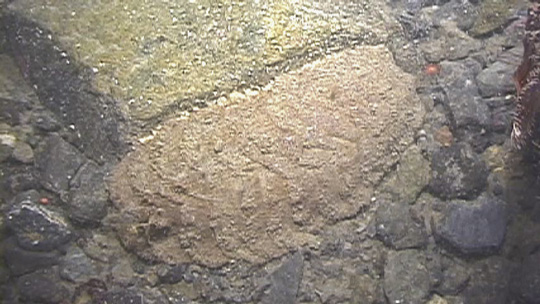
by David Cothran, undersea specialist for Lindblad Expeditions-National Geographic
I was descending a steep muddy slope near Crystal Hill, in the Weddell Sea. More or less feeling my way along, I continued down to about 60 feet, stopping when I was lucky enough to come across a group of Antarctic feather stars. I had just started filming them when something moved among the rocks nearby. It was a scale worm, a flat, bristly creature also called a sea mouse. Very cool! I had only seen a few in the Antarctic and this one was quite large, about six inches long. It was difficult to get a good shot of it in the swirling mud, but I did my best and then moved on, looking for more strange polar marine life to share with our guests on the National Geographic Endeavour.

Not pretty, but really interesting; an unidentified scale worm in the Weddell Sea.
Back on the ship I tried to identify the unusual worm. According to my reading, all known Antarctic scales worms are quite a bit smaller than this one. What had I seen? Was it a species as yet undescribed by science? In places as remote as the Weddell Sea, it is quite possible to come across unknown animals, but it is also very difficult to know for sure that what you have found is really new. In order to establish a new species, scientists must examine specimens in the laboratory and publish a definitive descriptive paper, called a monograph. In this case there was no way to do that, but it was still an exciting possibility and worth a casual report to some friends in the scientific community.

Shadows and light at the entrance to Woodfjord.
In the remote and beautiful wilderness areas where we travel on Lindblad-National Geographic expeditions, this kind of thing happens every once in a while. For me, the most interesting encounter of all was in the Arctic archipelago of Svalbard, on a day when I was using our ROV to look at the bottom of Woodfjord, about 300 feet below the surface. The creature I found there looked very much like a small brown mushroom, but as I carefully focused the camera for a better look, it slowly unfolded, opening a crown of branched tentacles that it raised to form an upturned cup. The Antarctic worm was unusual, but at least I knew what kind of animal it was. This was really strange! I had never seen anything like it and couldn't even guess what it was related to. And, as it turns out, neither could any of the expert marine biologists I have shown it to.
We don't yet know if either the scale worm or the strange mushroom creature are really new species, but it is certainly both exciting to consider and compelling motivation to keep our eyes open as we continue to explore. One of the best things about traveling to remote wilderness regions like the Arctic and the Antarctic is the opportunity to encounter the unknown, and, through these encounters, to enrich ourselves and contribute to the ever-growing scientific understanding of our beautiful world.